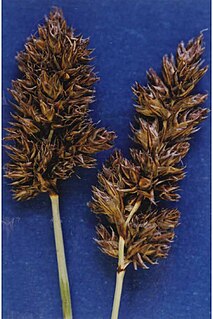Carex amplifolia is a species of sedge known by the common name bigleaf sedge. It is native to western North America from British Columbia to Montana to California, where it grows in wet and seasonally wet areas in coniferous forests.

Carex comosa is a species of sedge known as longhair sedge and bristly sedge. It is native to North America, where it grows in western and eastern regions of Canada and the United States, and parts of Mexico. It grows in wet places, including meadows and many types of wetlands. Tolerates deeper water than most common species and is good for retention basins. This sedge produces clumps of triangular stems up to 100 or 120 centimeters tall from short rhizomes. The inflorescence is up to 35 centimeters long and has a long bract which is longer than the spikes. It is a cluster of several cylindrical spikes. The scales over the fruits taper into long, thin awns.

Carex douglasii is a species of sedge known by the common name Douglas' sedge.

Carex filifolia is a species of sedge known by the common name threadleaf sedge. It is native to western North America and grows on slopes, eroded areas, gravel, and dry habitats.

Carex hassei is a species of sedge known by the common name salt sedge. It is native to western North America from British Columbia to Baja California to New Mexico, where it grows in moist places, such as meadows.

Carex hoodii is a species of sedge known by the common name Hood's sedge. It is native to western North America from Alaska to Nunavut to California to South Dakota, where it grows in dry to moist habitat in forests and on mountain slopes.

Carex jonesii is a species of sedge known by the common name Jones' sedge. It is native to the Western United States and grows in moist habitats.

Carex leptalea is a species of sedge known by the common names bristly-stalked sedge and flaccid sedge. It is native to much of North America including most of Canada, the Dominican Republic, and the United States. It only grows in wetlands. This sedge produces dense clusters of thin stems up to 70 centimeters tall from a network of branching rhizomes. The thin, deep green leaves are soft, hairless, and sometimes drooping. The inflorescence is up to 16 millimeters long but only 2 to 3 millimeters wide, and is yellow-green in color. There are only a few perigynia on each spikelet, and they are green and veined.
- Carex leptalea subsp. harperi(Fernald) W.Stone - southeastern US from Texas and Florida north to Missouri and Pennsylvania
- Carex leptalea subsp. leptalea - widespread from Alaska east to Nunavut and south to California and Dominican Republic
- Carex leptalea subsp. pacificaCalder & Roy L.Taylor - Washington State, British Columbia, southeastern Alaska

Carex luzulina is a species of sedge known by the common name woodrush sedge.

Carex mariposana is a species of sedge known by the common name Mariposa sedge.

Carex mertensii is a species of sedge known by the common name Mertens' sedge. It is native to western North America from Alaska to California to Montana, where it grows in moist and wet habitat in mountain forests and meadows. This sedge produces clumps of stems reaching maximum heights between 80 and 120 centimeters. The leaves are small; those toward the bases of the stems are reduced to sheaths only. The inflorescence is a densely packed, bullet shaped cluster of overlapping flowers, mainly hanging on long peduncles. Each inflorescence is generally 2 to 4 centimeters long. Each of the flowers has a dark-colored bract.

Carex nebrascensis is a species of sedge known as Nebraska sedge.

Carex neurophora is a species of sedge known by the common name alpine nerve sedge. It is native to the western United States, where it grows in wet mountain habitat such as meadows and streambanks. This sedge produces stems up to about 60 centimeters tall and inflorescences which are dense, oblong clusters of indistinguishable spikes of flowers.

Carex praeceptorum is a species of sedge known by the common names early sedge and teacher's sedge.

Carex praegracilis is a species of North American sedge known as clustered field sedge, field sedge, and expressway sedge. Carex praegracilis is cultivated in the specialty horticulture trade as lawn substitute and meadow-like plantings.

Carex raynoldsii is a species of sedge known by the common name Raynolds' sedge. It is native to western North America and grows in alpine to subalpine meadows.

Carex scoparia is a species of sedge known by the common names broom sedge and pointed broom sedge. It should not be confused with the unrelated grass species known as "broom sedge," Andropogon virginicus.

Carex simulata is a species of sedge known by the common name analogue sedge.

Carex concinna is a species of sedge known by the common names low northern sedge, northern elegant sedge, beauty sedge, and beautiful sedge. It is native to northern North America, where it occurs across Canada and in high elevations in the northern contiguous United States.

Carex eburnea, known as ivory sedge, ebony sedge, and bristleleaf or bristle-leaved sedge, is a small and slender sedge native to North America, from Alaska and Newfoundland south to central Mexico.



















